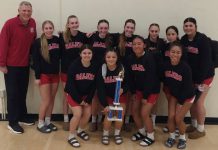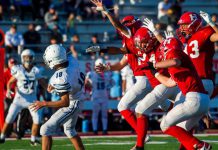Ramirez doesn’t deserve Hollywood
In one part of the country, he’s revered, like the next Kirk
Gibson.
In another part of the country, he’s considered a sickness, and
one that nearly sunk a franchise.
Follow the story of Manny Ramirez, who gave up while playing in
Boston but rejuvenated his year in Los Angeles, and you have one of
those sappy, tug-at-the-heartstrings type storylines, a true tale
of perseverance and rebirth.
Ramirez doesn’t deserve Hollywood
In one part of the country, he’s revered, like the next Kirk Gibson.
In another part of the country, he’s considered a sickness, and one that nearly sunk a franchise.
Follow the story of Manny Ramirez, who gave up while playing in Boston but rejuvenated his year in Los Angeles, and you have one of those sappy, tug-at-the-heartstrings type storylines, a true tale of perseverance and rebirth.
Manny, struggling to keep his job as a member of the Red Sox, battling even, finds hope in Dodger Blue, where he revives his career and leads Los Angeles to the Promised Land that is the National League Championship Series – the first time in 20 years.
Hollywood needs to start writing the script.
The only problem is that Ramirez was never injured, never sick, and never battled from any ailment whatsoever. He was not in a slump, not fighting to keep his job, and certainly not revered at the end of his career in Boston.
He was Manny. Nothing more.
Sadly, this is a storyline surrounding too many athletes.
In what will certainly be considered one of the greatest two-face performances by an athlete on any scale – greater even than one Randy Moss bolting Oakland for New England, only to “revive” his career one season later – Manny Ramirez has positioned Los Angeles four wins away from the World Series.
When this happened to Moss, everyone got mad at the disgruntled wideout, and for good reason. He moaned and groaned and didn’t play in Oakland, and even played his way out of Oakland, then delivered one of the greatest single seasons ever by a wide receiver one year later.
Certainly, he was not fooling anybody.
But the key difference in his situation is that he’s a wide receiver. If Moss could throw the ball to himself, I’m sure he would. But having Tom Brady around was certainly a step up from the three-headed quarterback situation in Oakland, and should certainly be factored in when discussing Moss’ two-face performance.
Yes, his actions in Oakland were terrible – you could always tell if he was the quarterbacks’ target because he’d actually finish running a route.
But with Manny, the situation is a tad different, only because baseball is so much more individual, and Scott Boras has so much more power.
Holding a team hostage is always one of my favorite terms to use – very Hollywood-like – and here’s what Ramirez did in Boston: In 365 at-bats, he had 190 hits, 20 home runs and 68 RBIs. He batted .299 with a .398 OBP and a .529 slugging percentage.
In Los Angeles, where Ramirez has 187 at-bats, he’s had 74 hits, 17 home runs and 53 RBIs. H has batted .396 with a .489 OBP and a .743 slugging percentage.
The difference in those numbers is practically obscene, especially when you consider that the only thing that changed was the zip code.
But in the sports world, where it’s always what-have-you-done-for-me-lately, players like Moss, like Ramirez, even like Terrell Owens and Vince Carter, get a free pass.
They may have sabotaged their previous teams, but as long as they can win with their current employer, all is forgiven in the sports world.
“It’s extraordinary – the dichotomy between what he was in Boston and what he is in Los Angeles,” broadcaster Tim McCarver told Mike Jensen of the Philadelphia Inquirer recently. “I mean, talk about wearing out your welcome in a town, and it was a long welcome with the Red Sox. But some of the things he did were simply despicable, despicable – like not playing, refusing to play. Forgetting what knee to limp on. And now it’s washed, it’s gone.”









